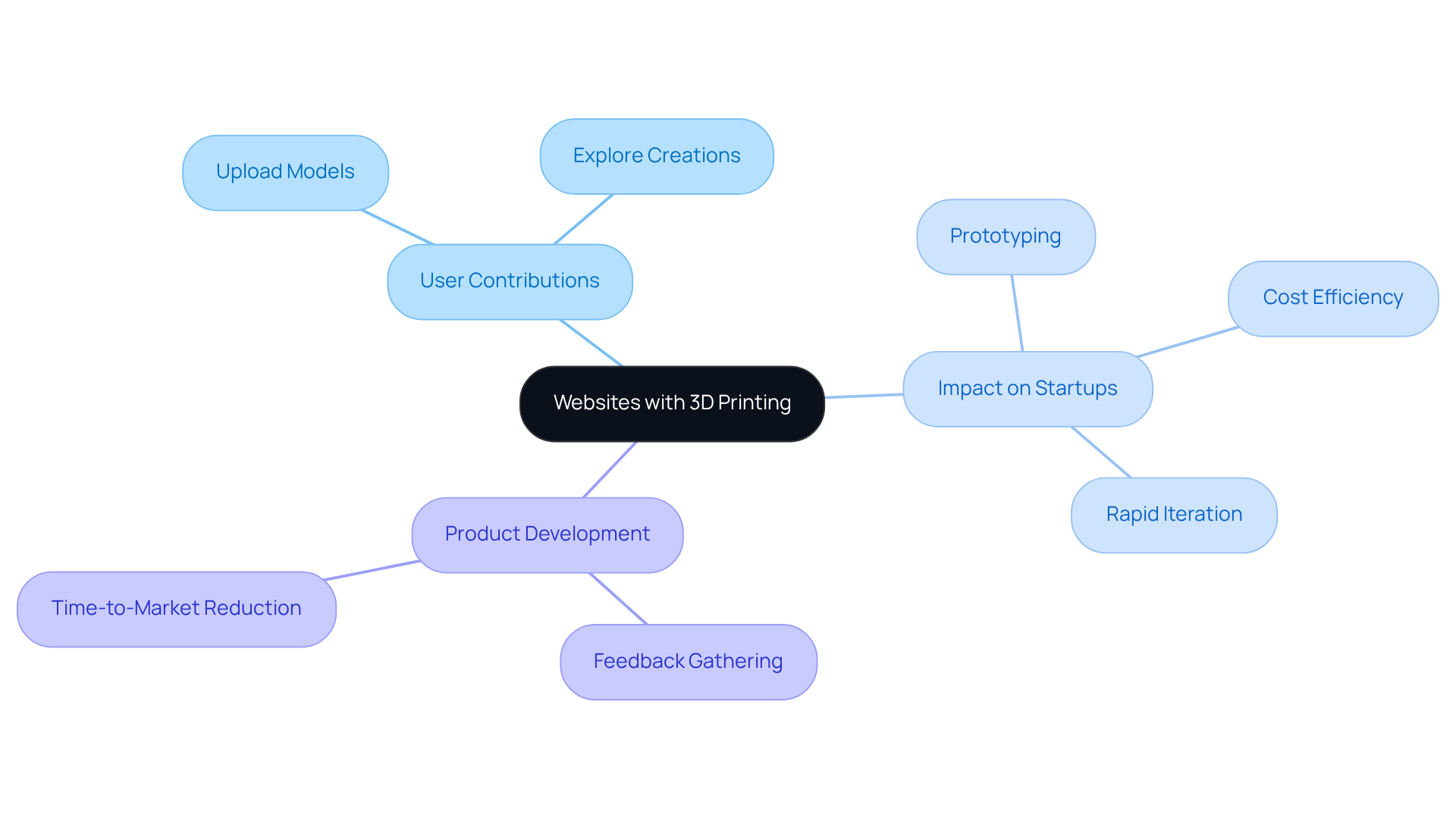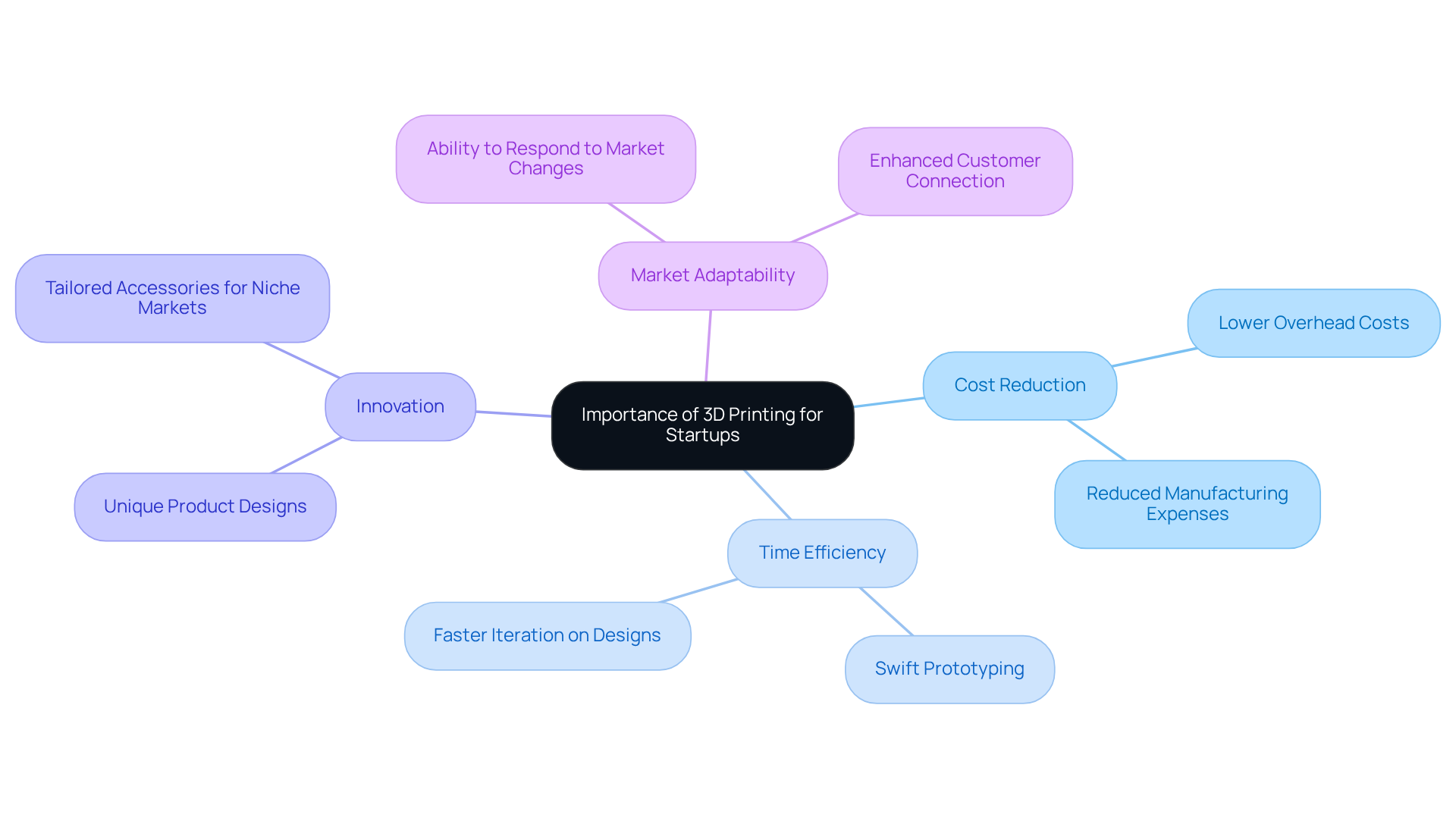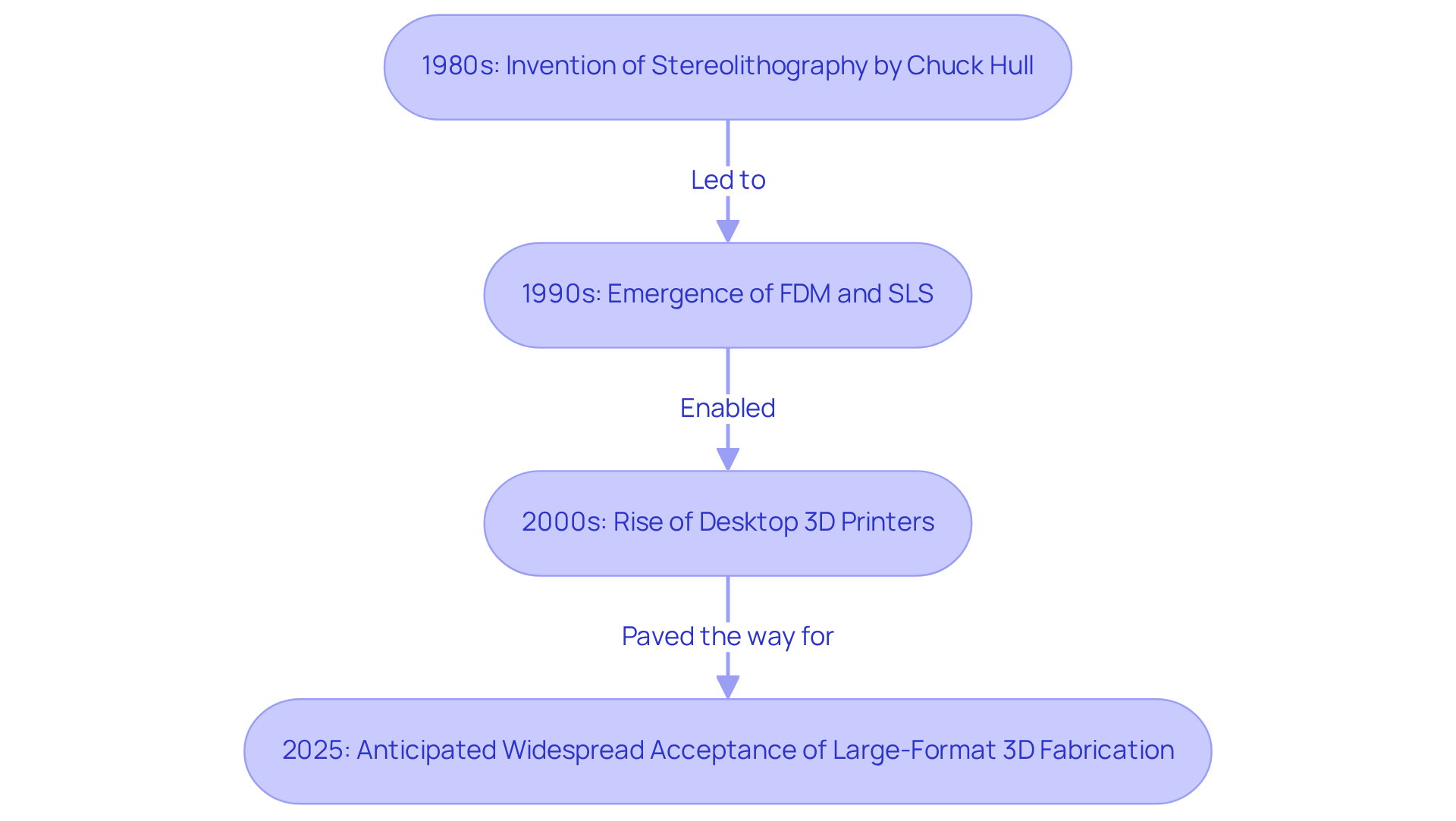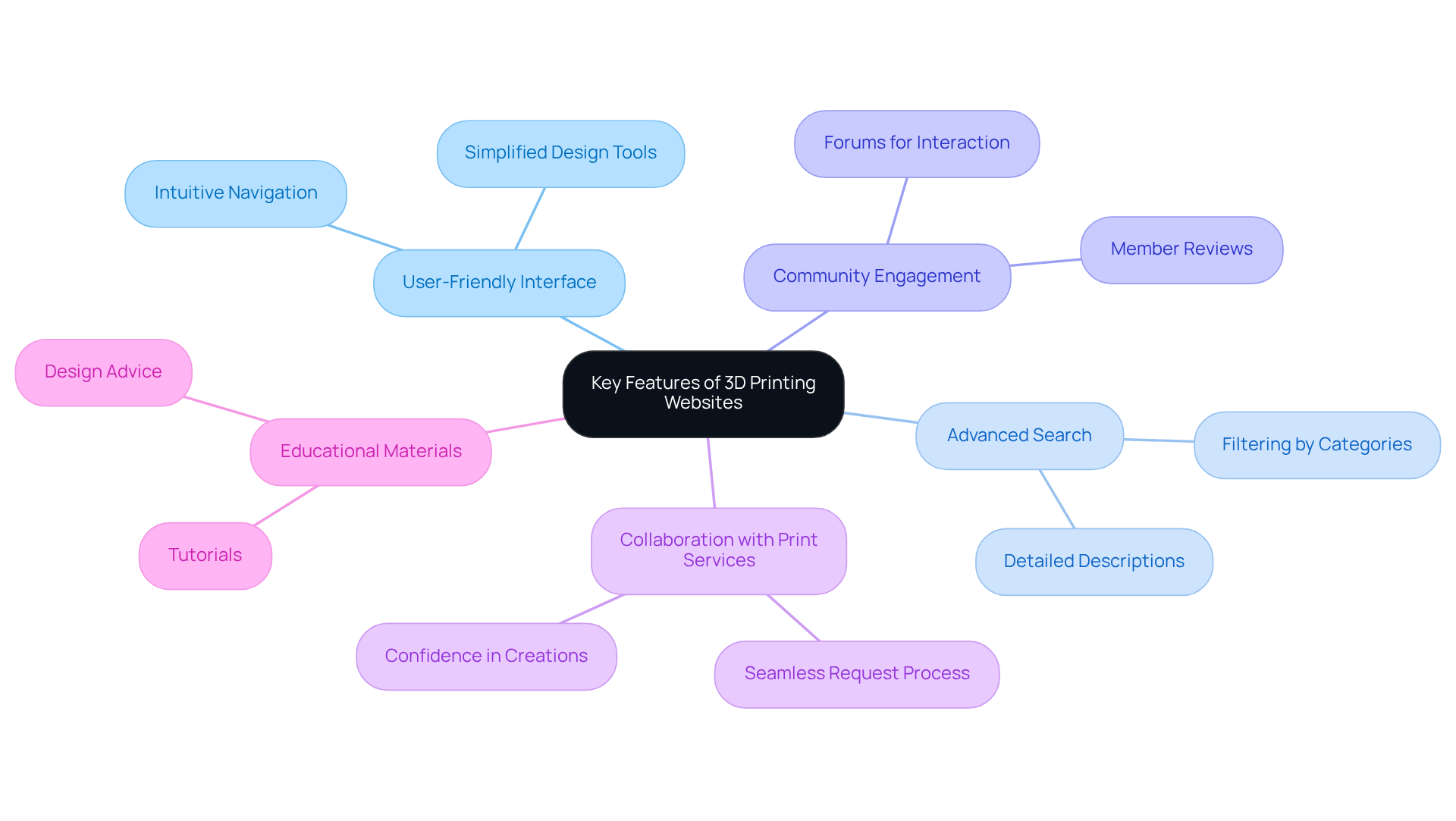Overview
The article delves into a significant challenge faced by many aspiring innovators: the difficulty in accessing advanced 3D printing technology. This barrier can stifle creativity and slow down product development, especially for startups eager to bring their ideas to life.
However, there's hope. Websites dedicated to 3D printing have evolved into vital resources that not only facilitate innovation but also empower users by democratizing access to this transformative technology. These platforms enable users to:
- Prototype efficiently
- Connect with like-minded communities
- Enhance their overall experience through intuitive design and valuable educational resources
By fostering a supportive environment, they nurture the creative spirit of entrepreneurs, making it easier for them to navigate the complexities of product development. Together, we can embrace these tools and turn challenges into opportunities for growth and success.
Introduction
In today's digital landscape, websites dedicated to 3D printing have become crucial platforms that connect virtual creativity with tangible production. Yet, many creators and entrepreneurs face challenges in accessing these advanced fabrication technologies. This gap can hinder innovation, especially for startups striving to move quickly and cost-effectively.
As the demand for rapid prototyping and design iteration increases, it raises an important question: how can these online resources be better optimized to truly support the needs of creators and entrepreneurs in our ever-evolving technological world?
By exploring this together, we can find ways to enhance these platforms, ensuring they nurture the creativity and ambition of those who rely on them.
Define Websites with 3D Printing
Websites with 3D fabrication serve as essential online spaces that empower the creation, sharing, and production of three-dimensional items. These websites with 3D allow individuals to upload their own models, explore a diverse array of existing creations, and access various printing services. They act as a vital bridge between digital creation and physical production, enabling users to transform their virtual innovations into tangible products. Notable examples of websites with 3D include Thingiverse and MyMiniFactory, which collectively host over 2 million user-generated 3D models, offering a rich library for both enthusiasts and professionals.
However, the significance of these systems extends beyond mere sharing; they play a crucial role in product development, particularly for startups. By tapping into the extensive resources available on websites with 3D, emerging companies can quickly and affordably prototype and iterate on designs. For instance, the sharp increase in released models during 2020, driven by the lockdown phase, highlights the growing reliance on these systems. This accessibility empowers startups to innovate without the heavy burden of extensive in-house resources, making in today’s fast-paced tech landscape.
Moreover, professional insights underscore the transformative impact of these systems on product development cycles. As Jared Schwitzke notes, RNO1's design-first mindset and meaningful results showcase the importance of rapid prototyping and testing. These platforms simplify the journey from concept to creation, allowing startups to gather feedback and make necessary adjustments before committing to full-scale production, significantly reducing time-to-market.
In conclusion, websites with 3D creation like Thingiverse and MyMiniFactory not only democratize access to 3D technology but also nurture innovation and collaboration, positioning them as essential tools for contemporary entrepreneurs. It’s important for users to remain mindful of potential layout issues; reading comments from others who have explored similar concepts can help identify any possible challenges. Together, we can navigate this exciting landscape and turn ideas into reality.

Explore the Importance of 3D Printing for Startups
For many startups, the journey of bringing an idea to life can feel daunting, especially when faced with the limitations of traditional manufacturing methods. These constraints not only slow down the process but also inflate costs, leaving founders feeling overwhelmed and uncertain about how to move forward.
However, there is a nurturing solution found on [websites with 3D fabrication](https://rno1.com/retrn). This innovative technology empowers startups to swiftly prototype and iterate on their product designs for websites with 3D, significantly reducing both time and expenses.
Imagine a startup in the fashion industry, for instance, that can create unique accessories tailored to niche markets. This not only enhances their but also allows them to connect more deeply with their customers.
Additionally, websites with 3D fabrication allow startups to operate with lower overhead costs, freeing them to innovate and adapt to ever-changing market needs. By embracing this technology, founders can transform their visions into reality, fostering a supportive environment for creativity and growth.

Trace the Evolution of 3D Printing Technology
The journey of 3D fabrication technology began in the early 1980s with Chuck Hull's invention of stereolithography, a remarkable breakthrough that enabled the layer-by-layer creation of three-dimensional objects. This innovative approach not only marked a pivotal moment in manufacturing but also opened doors to future advancements that could change lives. As we moved through the 1990s, techniques like fused deposition modeling (FDM) and selective laser sintering (SLS) emerged, expanding the possibilities of 3D fabrication across diverse sectors, each with its unique challenges and opportunities.
By the 2000s, this technology became more accessible to everyday consumers, leading to the rise of desktop 3D printers. This democratization of 3D fabrication has allowed various industries, including healthcare, aerospace, and automotive, to embrace its potential—whether for or producing end-use components. It's heartening to see how the integration of AI and machine learning is enhancing the efficiency and accuracy of these processes, paving a hopeful path for the future of this technology.
Looking ahead, statistics suggest that by 2025, large-format 3D fabrication is set to gain widespread acceptance across sectors, driven by advancements in speed, cost, and material diversity. Companies like Massivit 3D Printing Technologies are leading the charge, transforming traditional manufacturing into ultra-fast digital fabrication. As we witness this evolution, the potential for 3D technology to revolutionize manufacturing and design is not just substantial; it is inspiring. Together, we can navigate these changes and harness the power of innovation to meet the needs of our communities.

Identify Key Features of 3D Printing Websites
Navigating the world of 3D printing can often feel overwhelming. Many users struggle with complex interfaces and limited access to resources, which can lead to frustration and a sense of isolation. Imagine wanting to bring your creative ideas to life but feeling lost in a sea of technical jargon and inaccessible tools. This is a common experience that many individuals face when .
However, there is hope. A truly effective platform can transform this experience. By incorporating user-friendly interfaces, advanced search functionalities, and community engagement tools, websites with 3D printing can create a nurturing environment. Imagine smoothly navigating through an extensive library of 3D models, filtering by categories, and accessing detailed descriptions that empower your creativity. Community interaction through member reviews, ratings, and forums fosters a sense of belonging, allowing you to share your experiences and gain insights from others who understand your journey.
Collaboration with print services is another crucial aspect, offering a seamless way to request copies of your creations. This connection not only simplifies the process but also enhances your confidence in bringing your designs to life. Furthermore, educational materials like tutorials and design advice provide valuable guidance, enabling you to create high-quality models and enriching your overall experience on the platform.
Collectively, these features foster a positive user experience, motivating more individuals to explore and engage with websites with 3D printing technology. By addressing these challenges with compassion and understanding, we can create a supportive community that empowers you to unleash your creativity and fully embrace the possibilities of 3D printing.

Conclusion
In today's digital landscape, many face the challenge of accessing advanced technologies like 3D printing. This gap can feel daunting, especially for entrepreneurs eager to bring their innovative ideas to life. Fortunately, websites dedicated to 3D printing have emerged as vital resources, bridging the divide between virtual design and tangible production. They not only democratize access to this technology but also empower individuals, enabling them to transform their visions into reality with remarkable ease and efficiency.
As we reflect on the journey of 3D printing from its humble beginnings in the 1980s to its current significance across various sectors, including startups, it becomes clear how these platforms facilitate:
- Rapid prototyping
- Lower costs
- Encouragement of collaboration
This ultimately enhances the creative process, allowing ideas to flourish. Importantly, the user-friendly features of these websites ensure that anyone, regardless of their technical background, can effectively engage with 3D printing technology.
Given these insights, the importance of 3D printing websites is profound. As this technology evolves, it opens up exciting possibilities for both startups and established businesses to innovate and adapt in our fast-paced market. By embracing these platforms, entrepreneurs not only nurture their creativity and growth but also position themselves to thrive amidst increasing competition. Engaging with 3D printing technology today can lead to transformative outcomes, making it essential for innovators to explore and utilize these invaluable resources. Together, we can navigate this evolving landscape and unlock the full potential of our ideas.
Frequently Asked Questions
What are websites with 3D printing?
Websites with 3D printing are online platforms that enable users to create, share, and produce three-dimensional items. They allow individuals to upload their own 3D models, explore existing creations, and access various printing services.
What is the purpose of these websites?
The purpose of these websites is to act as a bridge between digital creation and physical production, allowing users to transform virtual innovations into tangible products.
Can you provide examples of popular 3D printing websites?
Notable examples of websites with 3D printing include Thingiverse and MyMiniFactory, which collectively host over 2 million user-generated 3D models.
How do websites with 3D printing benefit startups?
These websites provide startups with extensive resources to quickly and affordably prototype and iterate on designs, enabling innovation without the need for significant in-house resources.
What impact did the COVID-19 pandemic have on 3D printing websites?
During the lockdown phase of 2020, there was a sharp increase in released models on these platforms, highlighting the growing reliance on websites with 3D printing for design and production.
How do these platforms affect product development cycles?
Websites with 3D printing simplify the journey from concept to creation, allowing startups to gather feedback and make adjustments before full-scale production, which significantly reduces time-to-market.
What should users be mindful of when using these platforms?
Users should be mindful of potential layout issues and can benefit from reading comments from others who have explored similar concepts to identify any challenges.
What is the overall significance of websites with 3D printing?
These platforms democratize access to 3D technology, nurture innovation and collaboration, and are essential tools for contemporary entrepreneurs.




